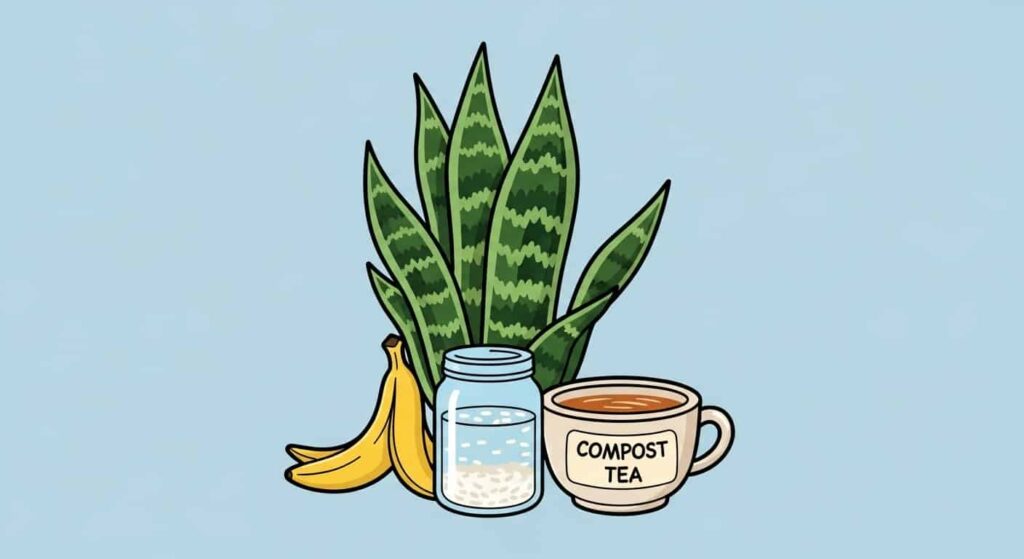How to Fertilize Snake Plant? (Quick Answer)
To fertilize a snake plant, use a balanced liquid fertilizer (like 10-10-10) diluted to half-strength. Apply it once a month during the spring and summer growing season. Avoid fertilizing in the fall and winter when the plant is dormant. Always water the plant before fertilizing to prevent root burn.
Why Your Snake Plant Deserves the Best Care

Snake plants, also known as Sansevieria or mother-in-law’s tongue, are celebrated for their resilience and striking architectural appearance. They are the champions of low-maintenance houseplants, tolerating low light, infrequent watering, and a wide range of environments. This toughness is why both new plant parents and seasoned collectors adore them. But even the most self-sufficient plant can benefit from a little nutritional support to truly flourish.
While your snake plant can survive on its own, providing the right nutrients can transform it from merely surviving to thriving. Proper fertilization encourages robust growth, enhances the vibrant green and yellow patterns on its leaves, and strengthens the plant’s overall health. It helps the plant build resilience against pests and diseases, ensuring it remains a beautiful and structural feature in your home for years to come.
This comprehensive guide will walk you through everything you need to know about how to fertilize snake plants. We will explore the best fertilizer for snake plants, including both commercial and homemade options. You’ll learn the precise steps for application, the ideal timing and frequency, and the common mistakes to avoid. By the end of this article, you will have the confidence and knowledge to provide the perfect plant food for snake plants, helping them grow stronger and look more stunning than ever.
Do Snake Plants Need Fertilizer?

One of the most frequently asked questions is, Do snake plants need fertilizer? The answer is a qualified yes. They don’t require heavy or frequent feeding like many other houseplants, but a strategic approach to fertilization makes a significant difference.
Snake plants are native to arid regions in Africa, where they grow in poor, rocky soil. This evolutionary background enables them to be highly efficient in utilizing available nutrients and water. They are, by nature, slow growers and can certainly live for years in the same pot without any added food for snake plants.
So, why bother with fertilizer for snake plants? Because “surviving” isn’t the same as “thriving.” The soil in a pot has finite resources. Over time, the plant will deplete its existing nutrients, leading to slower growth, less vibrant leaves, and a weaker constitution.
Here’s how fertilizing snake plants helps:
- Promotes Healthy Growth: A good snake plant fertilizer provides the essential macronutrients—Nitrogen (N), Phosphorus (P), and Potassium (K)—that fuel new leaf production and root development.
- Enhances Leaf Color: Proper nutrients for snake plants can intensify the deep greens and bright yellows of the leaves, making the plant a more dramatic focal point.
- Strengthens the Plant: Well-fed plants have stronger cell walls and more robust root systems, making them better equipped to handle environmental stress and resist pests.
Technically, your snake plant won’t die without fertilizer. But if you want to see it reach its full potential, incorporating a light feeding schedule into your care routine is a simple step with a big payoff.
When to Fertilize Snake Plant: Timing is Everything

Knowing when to fertilize snake plants is just as important as knowing what fertilizer to use. Applying nutrients at the wrong time can be ineffective at best and harmful at worst. Snake plants have a distinct growing season and a period of dormancy, and your fertilizing schedule should align with this natural cycle.
The Growing Season: Spring and Summer
The active growing period for snake plants is during the spring and summer months. This is when the days are longer, the light is brighter, and the temperatures are warmer. During this time, the plant is actively producing new leaves and expanding its root system. This is the ideal time to fertilize snake plants. The plant is primed to absorb and use the extra nutrients you provide. A consistent schedule during these months will support vigorous, healthy growth.
The Dormant Season: Fall and Winter
As the days shorten and temperatures drop in the fall and winter, snake plants enter a state of dormancy. Their metabolic processes slow down significantly, and growth comes to a near standstill. During this resting period, you should stop fertilizing completely.
Why? Because the plant isn’t actively using nutrients. Adding fertilizer to snake plants that can’t use it leads to a buildup of mineral salts in the soil. This can burn the roots, damage the plant’s health, and lead to problems like yellowing leaves or root rot. Let your plant rest during these colder months.
How Often to Fertilize Snake Plant
During the spring and summer growing season, the general recommendation for how often to fertilize snake plants is once every four to six weeks. Snake plants are sensitive to over-fertilization, so it’s always better to err on the side of caution. Less is more. If you use a very diluted fertilizer, you might apply it with every other watering, but a monthly schedule is a safe and effective starting point.
How to Fertilize a Snake Plant:

A Step-by-Step Guide
Now that you know what to use and when, let’s cover how to fertilize snake plants correctly. Following these steps will prevent common issues like root burn and ensure your plant gets the maximum benefit.
Step 1: Water Your Plant First
This is the most critical step. Never apply fertilizer to dry soil. Fertilizing a dry plant can scorch the roots, causing significant damage. Water your snake plant thoroughly as you normally would and let it drain for about an hour before you fertilize. The water acts as a buffer, protecting the delicate roots from the concentration A Step-by-Step Guide
Now that you know what to use and when, let’s cover how to fertilize snake plants correctly. Following these steps will prevent common issues like root burn and ensure your plant gets the maximum benefit.
Step 1: Water Your Plant First
This is the most critical step. Never apply fertilizer to dry soil. Fertilizing a dry plant can scorch the roots, causing significant damage. Water your snake plant thoroughly as you normally would and let it drain for about an hour before you fertilize. The water acts as a buffer, protecting the delicate roots from the concentrated mineral salts in the fertilizer.
Step 2: Choose and Dilute Your Fertilizer
Select your chosen snake plant fertilizer. If you’re using a standard liquid fertilizer like a 10-10-10 or 20-20-20, dilute it to at least half the recommended strength. For example, if the instructions say to use one teaspoon per gallon of water, use only half a teaspoon. For snake plants, a quarter-strength solution is even safer and often sufficient.
Step 3: Apply the Fertilizer Solution
Pour the diluted fertilizer solution evenly over the soil surface, just as you would when watering. Try to avoid splashing the mixture on the leaves, although a few drops won’t cause harm. The goal is to deliver the nutrients directly to the root zone. Ensure the solution drains freely through the bottom of the pot.
Step 4: Stick to the Schedule
Mark your calendar or set a reminder to fertilize once a month during the spring and summer. Consistency is helpful, but don’t worry if you miss a feeding. It’s far better to under-fertilize than to over-fertilize. Remember to cease all feeding during the fall and winter.
Homemade and Natural Fertilizer for Snake Plant

If you prefer a more organic and budget-friendly approach, there are several effective snake plant fertilizer homemade options. These natural solutions provide a gentle source of nutrients without the risk of chemical burn.
Compost Tea
Compost tea is a nutrient-rich liquid made by steeping finished compost in water. It’s teeming with beneficial microbes and a balanced mix of nutrients. To make it, place a scoop of compost in a cloth bag or old stocking and let it soak in a bucket of water for 24-48 hours. Use the resulting “tea” to water your snake plant once a month.
Banana Peel Water
Banana peels are a fantastic source of potassium, which is excellent for overall plant vigor. Simply chop up a banana peel and let it soak in a jar of water for a few days. The water will absorb the potassium and other trace minerals. Use this infused water to feed your plant.
Rice Water
The cloudy water left over from rinsing rice is a mild but effective natural fertilizer for snake plants. It contains starches and trace minerals that can give your plant a gentle boost. Use it immediately after rinsing your rice, as it can ferment and spoil if left sitting out.
Coffee Grounds
Used coffee grounds can add a small amount of nitrogen to the soil. However, they are acidic and should be used with extreme caution. Too much can lower the soil’s pH and harm your plant. If you want to try it, sprinkle a very small amount—no more than a teaspoon for a 6-inch pot—on the soil surface once or twice per season. Mixing them into compost first is a safer bet.
Is Milk Good for Snake Plants?
You may have heard the tip to add milk to snake plant soil. Milk contains calcium and proteins that can theoretically benefit plants. However, this is a risky practice. The fats and sugars in milk can lead to foul odors as they decompose, attract pests like fungus gnats, and encourage the growth of harmful bacteria and mold in the soil.
If you are determined to try it, you must use it sparingly and highly diluted (at least one part milk to five parts water). A safer way to provide calcium is by using crushed eggshells, which break down slowly without the negative side effects of milk. In general, it’s best to stick to safer options like compost tea or a balanced liquid fertilizer.
Can I Use Orchid Fertilizer on Snake Plant?

This is a common question, as many plant owners have multiple types of plants. The answer is yes, you can use orchid fertilizer on a snake plant, and it’s actually a pretty good option. Orchid fertilizers are typically very gentle, low-nitrogen formulas designed not to burn sensitive orchid roots. This “weakly, weekly” approach aligns well with the snake plant’s preference for light feeding. Just be sure to follow the dilution instructions, and your snake plant should respond well.
Other Potential Nutrient Additives
While a balanced fertilizer is usually enough, some enthusiasts experiment with specific supplements.
Ferrous Sulfate for Snake Plants
Ferrous sulfate for snake plants can be used to correct an iron deficiency, which can cause yellowing leaves (chlorosis). However, iron deficiency is rare in snake plants unless the soil pH is too high. Before adding supplements like this, it’s best to ensure you are using a good potting mix and a balanced fertilizer, as these usually contain sufficient iron. Only use ferrous sulfate if you are confident that iron is the specific problem.
Common Fertilizing Mistakes to Avoid

More snake plants are harmed by over-care than neglect. When it comes to using fertilizer on snake plants, here are the most common mistakes to avoid.
- Over-fertilizing: This is the number one mistake. Too much fertilizer leads to a buildup of salts in the soil, which “burns” the roots. Signs of over-fertilization include brown, crispy leaf tips, yellowing leaves, and a white crust forming on the soil surface. Always dilute and apply sparingly.
- Fertilizing in Winter: As mentioned, feeding a dormant plant is a recipe for disaster. The plant cannot use the nutrients, leading to root damage. Stop all feeding from fall through winter.
- Using the Wrong Formula: Avoid high-nitrogen fertilizers designed for heavy-feeding foliage plants. These can cause weak, leggy growth in snake plants. Stick to a balanced or low-nitrogen formula.
- Fertilizing a Stressed Plant: Never fertilize a plant that is already struggling with root rot, pests, or disease. The fertilizer will only add more stress. Address the underlying issue first, let the plant recover, and then resume a gentle feeding schedule.
Conclusion: Your Path to a Thriving Snake Plant

Snake plants have rightfully earned their reputation as nearly indestructible houseplants. They ask for very little but give back so much with their air-purifying qualities and elegant, modern aesthetic. While they can survive on their own, providing the best food for snake plants will elevate them from survivors to spectacular specimens.
The key to success is a “less is more” approach. A diluted, balanced liquid fertilizer or a specialized succulent formula, applied just once a month during the spring and summer, is all they need. Whether you choose a commercial plant food for snake plants or a homemade fertilizer for snake plants like compost tea, the principles remain the same: feed lightly and only during the growing season.
By avoiding common mistakes like over-fertilizing and winter feeding, you ensure that your efforts help, not harm. Your reward will be a snake plant with stronger, taller leaves, richer color, and robust health to grace your home for many years to come.
FAQs
What is the best fertilizer for snake plants?
The best fertilizer for snake plants is a balanced liquid fertilizer (e.g., 10-10-10 ratio) or a formula made specifically for cacti and succulents. Always dilute it to half-strength to avoid burning the roots.
How often should I fertilize my snake plant?
You should fertilize snake plants once a month only during the spring and summer growing season. Do not fertilize in the fall and winter when the plant is dormant.
Can I make homemade fertilizer for my snake plant?
Yes, snake plant fertilizer and homemade options are great. You can use compost tea, water from soaked banana peels, or leftover rice water. These provide gentle, natural nutrients.
Is it okay to use milk on my snake plant?
It is generally not recommended. While milk contains calcium, it can also cause bad odors, mold growth, and attract pests. Safer alternatives like diluted liquid fertilizer or compost tea are better choices.
Should I fertilize my snake plant right after repotting?
No, wait at least four to six weeks after repotting before you fertilize. Fresh potting mix contains nutrients, and the plant needs time to recover from the stress of being moved.
What are the signs of over-fertilizing a snake plant?
Signs include brown or crispy leaf tips, yellowing lower leaves, stunted growth, and a white, salty crust on the surface of the soil. If you see these signs, flush the soil with water and stop fertilizing.

